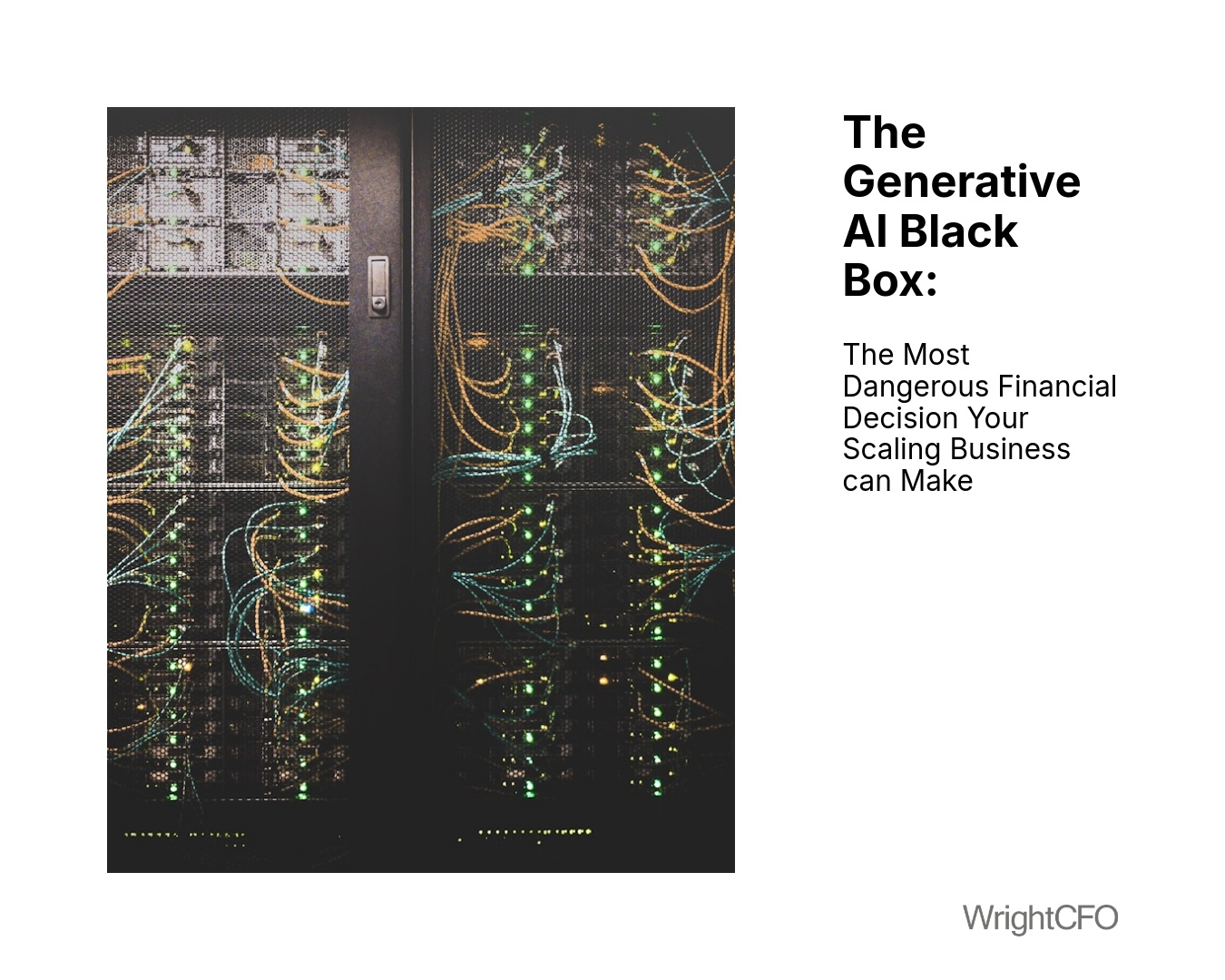The Generative AI Black Box: The Most Dangerous Financial Decision Your Scaling Business Can Make
The greatest risk in finance today isn’t avoiding AI; it’s blindly trusting it.
The conversation around Artificial Intelligence in finance has finally matured. It is no longer a question of if it will change the CFO function, but how. For scaling businesses in the £1M–£10M revenue bracket—particularly in the volatile tech, media, and creative sectors—AI offers unprecedented efficiency.
But here is the new, paramount danger: The AI Black Box.
The moment a business relies on AI for strategic predictions—such as cash flow forecasting, churn analysis, or advising on major investment—without understanding how the algorithm reached its conclusion, they are betting their entire company on a machine they cannot audit or explain. For a scaling SME, the financial consequences of a black-box failure are catastrophic.
The CFO’s new role is not merely adopting AI; it is governing it. That means understanding and managing the risks of the AI Black Box—where algorithms make decisions that even finance leaders can’t fully explain. This newsletter provides the blueprint for how scaling UK businesses can implement AI responsibly, strategically, and measurably.
Part 1: The ‘How’ of Implementation: Why Process Trumps Software
Before investing in tools, businesses must first diagnose weak processes to ensure they don’t automate the wrong workflows into an AI Black Box. A lot of the industry discussion is theoretical. For SMEs, it’s not about the ‘what’ of AI, it’s about the ‘how’, and it needs to be immediately practical.
My first tip is always: start with a clear process map. AI will amplify whatever process you put it on, so if you automate a broken workflow, you just get chaos much faster. Before buying any software, we advise our clients to map their end-to-end finance processes and identify the bottlenecks. This simple diagnostic is often the most critical stage of finance transformation.
Focus on ‘Quick Win’ Use Cases
Adoption has to deliver early, tangible results to build team buy-in and prove the ROI early. We recommend starting with ‘quick win’ use cases that instantly relieve resource strain:
- Invoice Capture: Automate using Optical Character Recognition (OCR) and AI categorisation.
- Basic Queries: Deploy a simple internal chatbot to handle queries like, “What’s the budget for Q4 marketing?”
My colleague, Kadia Barry (FCCA), often references a small retail SME we work with. By deploying a system like Dext integrated with Xero, they managed to cut their fundamental bookkeeping time by half in the very first month. That’s a measurable win that the whole business can feel immediately.
AI Success is a Human Effort: The Upskilling Imperative
Crucially, AI success is a human effort. You must upskill your team. Finance professionals, especially those trained in strategic methodologies, need to be comfortable with prompt engineering and validating the AI’s output. They evolve from the data processors to the data reviewers and strategists. People who are mastering AI for their personal productivity will be the undisputed leaders in any field they work in.
Part 2: Avoiding the AI Black Box When Selecting Technology Partners: The Three-Stage Approach
When evaluating vendors, demand transparency. If a tool can’t explain its logic, it’s another AI Black Box waiting to happen. The beauty of today’s finance tech landscape is that SMEs can adopt a staged approach, rather than needing a massive, enterprise-wide overhaul. At WrightCFO, we see three clear entry points:
Stage 1: Automate Admin This focuses on immediate time-savers, such as OCR for invoice and expense tracking, and bank feed categorisation. Tools like Dext, AutoEntry, or Pleo are great examples here.
Stage 2: Data Insights Once the data is cleaner, SMEs can move to AI-powered cash flow forecasting, churn prediction, and revenue recognition automation. Tools like ScaleXP or Float fit this niche, helping finance teams deliver better decision-making to leadership.
Stage 3: AI-Powered Advice This is the strategic layer, using finance copilot chatbots for dynamic ‘what if’ scenario modelling. We’re starting to see SMEs use tools like Microsoft Copilot or certain ChatGPT plugins to empower a truly strategic finance function.
Demanding Explainability and Integration
When it comes to vendor selection, the primary technical consideration is integration. You must avoid tools that operate in isolation; a new tool that creates a new data silo is not a solution, it’s a new problem.
However, the most critical non-technical demand you must make is for data privacy transparency and AI explainability. If the machine cannot show its workings—how it reached its conclusion—the risk belongs entirely to you.
Part 3: Measuring ROI and Reducing AI Black Box Risk
If you can’t measure the Return on Investment, your AI adoption is just an unnecessary IT expense. The good news is that measuring AI ROI in finance is highly measurable using tangible business impacts:
- Time Saved: Quantify this by comparing pre- and post-AI hours spent on a task. For example, reducing the monthly close process from eight days to three days.
- Cost Savings: Calculate the reduction in overtime or the need for new full-time employees (FTEs). For example, saving £15,000 annually by fully automating invoice entry.
- Decision Quality: Faster, AI-supported cash flow insights lead to improved liquidity and capital management. This can be quantified by tracking an increased average cash buffer or a reduction in emergency borrowing.
- Risk Mitigation: Quantify fraud prevented or compliance breaches avoided. For example, AI anomaly detection preventing a £10,000 fraud attempt.
To prove the ROI—which is what investors or the board will demand—you must first create a baseline. Track your current manual workload costs and error rates before implementation. At WrightCFO, we always help our clients link this ROI back to the overarching business goals.
Part 4: The SME Advantage: Strategic Evolution, Not Revolution
The challenges facing finance professionals in SMEs—who are often running the entire function—are fundamentally different to what huge enterprises face. The key difference is always resources and bandwidth.
Here are the four key challenges facing scaling SMEs:
- Limited Resources: Smaller budgets, fewer staff, and no dedicated in-house tech teams. The finance team wears multiple hats: bookkeeping, forecasting, compliance, and more.
- Data Quality Issues: Growth is often organic, systems are reactive, and data is often siloed or stuck in outdated spreadsheets.
- Change Management: Staff may fear replacement, and SMEs lack the HR capacity for structured change programmes to manage staff transition and upskilling.
- Vendor Confusion: The sheer volume of tools and platforms is overwhelming, with unclear pricing and complex integration needs.
These challenges exist because SME growth is often reactive, not strategic. The finance team is constantly fighting fires, leaving little to no time to properly explore, select, or implement new technology.
My final takeaway is that for an SME, AI success is a gradual evolution, not a disruptive revolution. It’s about being deliberate: mapping processes, piloting one high-impact use case, and clearly measuring the ROI to build confidence. That’s how a small finance team can unlock the kind of efficiency and insight once reserved only for the largest corporations.
The AI Black Box Conclusion: AI is the future of efficiency, but only human strategic governance can manage its risk. Demand transparency, audit the process, and never let the machine make an unexplainable decision on your behalf.
Are you ready to transition your finance function from data processors to strategic partners?
At WrightCFO, we provide the experienced Fractional CFO expertise to define your AI roadmap, ensure governance, and measure the ROI that truly drives profit for your scaling tech, media, or creative business.
Contact us today to build an AI strategy that is transparent, measurable, and scalable.
This article was originally published here on LinkedIN on October 1st, 2025.






